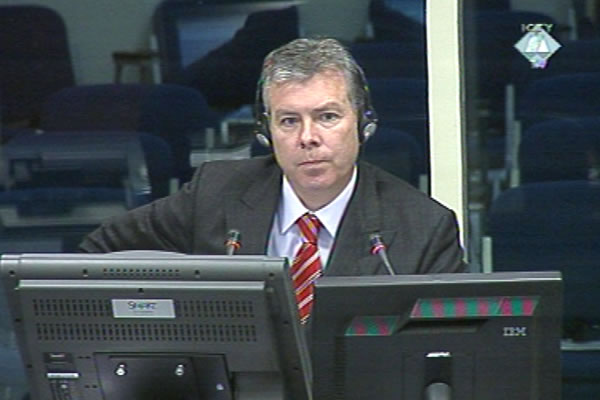Home
VRS OPERATIONS WERE BASED ON STRATEGIC GOALS
The prosecution military expert contends that the strategic goals set by the political leadership on Pale were the basis for VRS operations. According to the expert, the accused Ratko Mladic had to have received reports about the attacks on non-Serbs in Bosnian Krajina and about the conditions in prison camps
 Ewan Brown, witness at the Ratko Mladic trial
Ewan Brown, witness at the Ratko Mladic trial Prosecution military expert Ewan Brown presented his expert report, Military Situation in the Bosnian Krajina in 1992, at the trial of Ratko Mladic.
In early 1992 in Bosnia and Herzegovina the JNA ‘operated on two tracks’. On the one hand, the JNA troops were deployed throughout the country in order to ease the interethnic tensions, while on the other, it directly helped Bosnian Serbs. In the entry on 30 April 1992 of his war-time diary, Mladic wrote that General Adzic, the Chief of the JNA General Staff, assured him the JNA would remain in the Serb regions despite the official line which was that the JNA would pull out of BH.
In his report Brown presented in detail the transformation of the JNA 5th Corps into the VRS 1st Krajina Corps that operated in Bosnian Krajina. Mladic received reports about what happened to the non-Serbs in Bosnian Krajina, Brown claimed. Among the documents that corroborate the claim is a report sent on 12 May 1992 to the 2nd Military District, at the time when he was its commander. The report speaks in detail about the mass exodus of Croats and Muslims from Donji Vakuf. Brown included the combat reports of the 1st Krajina Corps in the same category of documents. The combat reports speak about the large number of non-Serbs captured after the cleansing operations. On top of that, on 30 April 1992 Mladic wrote in his diary under the heading Enormous Damage the following words: ‘Arkan in Bijeljina; Foca razed to the ground, looting, arson; burning of Croatian villages in Kupres; shelling of the old part of Sarajevo’. All that, Brown concluded, shows that Mladic knew what was going on in the field.
The analysis of political and military of documents made it possible for Brown to establish a direct link between the military operations and the six strategic goals of the Bosnian Serbs. Karadzic presented the goals on 12 May 1992 to the RS Assembly; the VRS was formally established at that session. Mladic warned the politicians at the session that ‘people are not little stones or keys’ that can easily be moved from pocket to a pocket. The attempt to move them could easily lead to ‘genocide’ that the ‘political leadership will have to explain’. Mladic went on to conclude that they should be ‘cautious’ and all their actions ‘should remain top secret’. Finally, a report of the VRS Main Staff on combat readiness in 1992 states that the goals ‘served as a general guideline, providing as a basis for the planning of VRS operations’.
Brown concluded that the Main Staff had to have been informed about the conditions in prison camps, especially in Manjaca. However, the annual report prepared by the Main Staff is not critical of the operations conducted by the 1st Krajina Corps that resulted in civilian victims and makes no mention of the prison camps at all.
At the beginning of the cross-examination, Mladic’s defense counsel Branko Lukic tried to contest the witness’s claim about the JNA’s ‘partiality’. According to the defense, the JNA had to protect Serbs in Croatia and Bosnia because the other two sides had obtained arms and were gearing up for the war. Ewan Brown’s evidence continues on Thursday.
Linked Reports
- Case : Mladic
- 2013-11-18 PROSECUTION EXPERT WITNESS USED INAPPROPRIATE’ TERMINOLOGY
- 2013-11-15 TRIAL CHAMBER ORDERS MEDICAL EXAMINATION FOR MLADIC
- 2013-11-14 HUMAN SHIELD ON MOUNT JAHORINA
- 2013-11-22 NUTRITIONIST IN MANJACA PRISON CAMP
- 2013-11-25 ABOUT PRISONERS ‘INDIRECTLY, WITHIN LIMITS OF LEGALITY’
- 2013-11-26 VALID INSTRUCTIONS AND UNAUTHORIZED ORDERS
